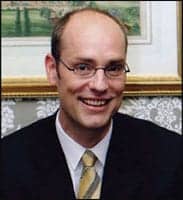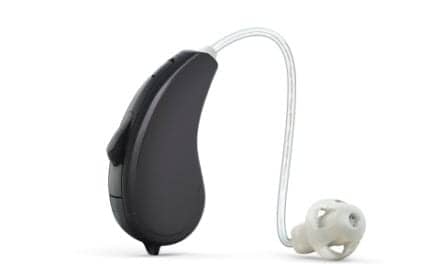
|
| Bjørn Christ, ReSound US president. |
When the dust finally settled from what would have been the largest merger in the industry’s history—the Sonova (Phonak Group) acquisition of GN ReSound and GN Otometrics, a deal that was blocked by German antitrust authorities—the GN board decided that its best option would be to retain its hearing care companies and to move forward as fast as possible with a new leadership plan. GN was facing some interesting challenges and opportunities.
Bjørn Christ, who was recently appointed the new president of ReSound US, has his own perspectives on the situation. Christ (last name rhymes with “wrist”) is a Danish macroeconomist who started his career at Minneapolis-based Control Data—the Dell Computer of its day—and has come full circle in his career to head up yet another technology company with strong ties to Minneapolis. In between, he has served as an editor for a Scandinavian computer magazine, implemented enterprise resource planning systems at Price Waterhouse, and worked at McKinsey & Company, a management firm where he advised Ericsson, Carlsberg, and BP/Amoco on issues of strategy, organization, and technology.
One of Christ’s assignments in his first years at GN ReSound was to manage the integration of companies purchased by GN Danavox, including ReSound, Beltone, Philips Hearing Instruments, and Viennatone. Although he enjoyed this type of internal consulting, he longed for the opportunity to actually lead a company.
That opportunity came in 2003, when he became the general manager of GN ReSound in Japan. “The object was to grow the business in Japan,” Christ says. “It was a life-defining experience on a professional and personal level [his wife and two kids adapted well to Japan], and with the support from dedicated employees, we were able to grow the division by 20% per year relative to the top line, and nearly double that in terms of the bottom line,” according to Christ. Within 4 years, ReSound’s market share doubled and today exceeds 10%, positioning GN as Japan’s third-largest hearing aid manufacturer.
But this result did not come without challenges. When you are in a country where you cannot talk in depth with your staff or customers due to a language barrier, or where you cannot read financial reports because “Azure” and other products are spelled in Japanese Kanji characters, then you have to rely on some steadfast organizational principles.
“As a manager,” Christ says, “it becomes apparent that you have to do something else … and that ‘something’ is, in fact, what every leader should be doing anyway: To develop, rely on, and coach your team of people. A leader should be identifying, attracting, growing, and retaining talented people who are right for the company’s structure. Of course, the leadership must also work on the structure to match the opportunities that are present in the market. So, you have to keep your eyes open and staff your company accordingly.”
He says the experience in Japan demonstrated to him that connecting with people, coaching them, and providing them with the inspiration to strive for relentless improvement is at the heart of effective management.
The Bright Side of the Blocked Merger with Sonova
It’s not exactly a trade secret that ReSound lost market momentum in the lead-up to the merger, which was blocked by German antitrust authorities on the grounds that the resulting industry structure would have constituted an “oligopoly” (see the August 23 edition of HR‘s weekly e-newsletter, The Insider). During the drawn-out process, ReSound found itself in something of a holding pattern, launching a limited number of products while trying to prepare for a new leadership structure.
Having participated in other mergers and acquisitions in his previous career, Christ is both philosophical and realistic about the subsequent fallout. His optimism stems from the fact that ReSound’s research and development efforts were never curtailed at any time, and a large number of new products and technology are now ready to be launched. “R&D was never sitting on its hands,” Christ says. “We are now in a situation where we have incredible technology and a large number of products ready for the market, with more launches scheduled in 2008 than ever before in ReSound’s history.”
However, he admits that the planned acquisition consumed a large amount of the company’s resources. “The key to good mergers is that you complete them in about 3 months,” Christ explains. “[The planned merger with Sonova] took 18 months, and ultimately it never happened. So, irrespective of which industry or which companies you’re looking at, this would have been a problem. In this case, nobody really made a mistake; everybody did exactly what they were supposed to do.
“When you look at the facts, ReSound actually built extraordinary value into the company from all its [previous] acquisitions, then integrated and turned these acquisitions into a value three times larger than the original company. In other words, GN ReSound is a tremendous success. No one, including Sonova or our other esteemed competitors, could have envisioned German antitrust forces barring our relatively small industry from consolidation.
“So, there’s really nothing to hide about our story,” Christ says. “We essentially are where we are as a consequence of [the failed merger]. But it may be wise to think about the following: Why did the German antitrust authorities oppose this merger? When you combine two companies that yield a [German] market share of about 20%, it’s certainly not a monopoly. Although we can quibble about what constitutes an ‘oligopoly,’ as the German antitrust authorities characterized it, they are correct that we would have brought a new dynamic to the marketplace. So, while I don’t want anyone to get the idea that I’m praising the German antitrust authorities, there is a potential bright side to their ruling: It’s possible that we have a situation where some of our professional dispensing partners are saying, ‘This [blocked merger] is not a bad thing because it keeps our choices intact.’ I think HR readers have generally benefited from the comparatively large number of suppliers in the hearing care market … and what I’m hearing from our customers is positive feedback about the blocked merger attempt. In fact, I have not heard a single customer tell us that they wanted to see the merger go through.
“When I got here [to the US market], I found a very talented group of employees who needed to be redirected after the acquisition was vetoed by the German authorities—and, since people are everything, that makes me very optimistic for the future.” Christ states that the success of Azure, ReSound’s high-end product line, has substantially blunted the impact of the failed merger and helped boost the company’s bottom line. He predicts that the company’s newest line of hearing aids, dot, is also going to make a major impression on the market. Due to the company’s heightened focus on product launches, he says the marketing department’s resources have increased by about 500% in 2008.
Delivering Value
From his experiences at ReSound Japan, Christ has acquired an appreciation for the role that quality and service can play in enhancing a company’s market position. “Our ultimate goal is to add more value to the customer in the short term,” he says. “Although it’s true we are a commercial enterprise, our mission is to develop and bring to the market products and services that have a direct value relative to hearing benefit for the end user. Historically, I think that’s something ReSound has been very good at; our company has done well to define the core issues for improving hearing. For example, the entire open-fit idea became a revolution for the industry when ReSound Air was introduced in 2003. Everyone acknowledges that ReSound was far ahead of the curve in this respect. So, I think it’s safe to say we will continue to move down the road as a company that focuses on unique technology-changing devices and end-user benefit.
“[In upcoming product launches] you will see that we are continuing to innovate form factors that give the consumer more usable gain and better [cosmetic] choices,” Christ says. “We are also looking into areas that I’m reasonably confident no one else has looked at before. In fact, our dilemma at this point is what to launch and when to launch it. We have four competing products to bring forward on a timeline, and it comes down to the question, ‘Which will be the most important for the end user, the industry, and our company’s growth?’ ”
He calls this a “luxury problem”—and with the current workforce feels optimistic that there are several bright points that can be seen in an historic merger that never was.





